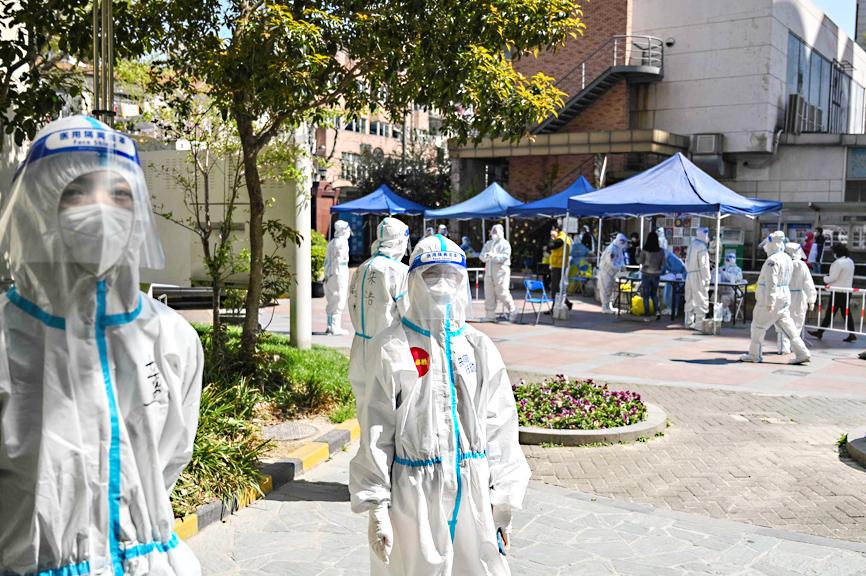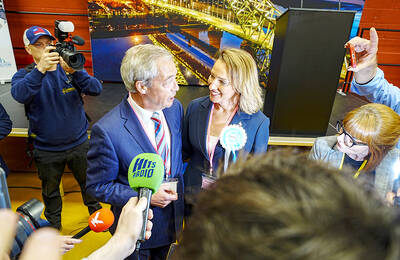China has sent the military and thousands of healthcare workers into Shanghai to help carry out COVID-19 tests for all of its 26 million residents as cases continued to rise yesterday, in one of the nation’s biggest-ever public health responses.
Some residents woke up before dawn for white-suited healthcare workers to swab their throats as part of nucleic acid testing at their housing compounds, many lining up in their pajamas and standing the required 2m apart.
The People’s Liberation Army on Sunday dispatched more than 2,000 medical personnel to Shanghai, an armed forces newspaper reported.

Photo: AFP
More than 10,000 healthcare workers from provinces such as Jiangsu, Zhejiang and Beijing have arrived in Shanghai, state media reported, showing them arriving, suitcase-laden and masked, by high-speed rail and aircraft.
It is China’s largest public health response since it tackled the initial COVID-19 outbreak in Wuhan, where the coronavirus was first discovered in late 2019.
Shanghai began a two-stage lockdown on Monday last week that has been expanded to confine practically all residents to their homes.
China yesterday reported more than 13,000 new cases nationwide in the previous 24 hours, of which nearly 12,000 were asymptomatic and about 9,000 were in Shanghai. The other large outbreak is in Jilin Province, where new cases topped 3,500.
Although the outbreak is small by global standards, the city has emerged as a test of China’s elimination strategy based on testing, tracing and quarantining all positive cases, as well as their close contacts.
The exercise in China’s most populous city takes place on the eve of when Shanghai initially said it planned to lift the city’s lockdown.
The nation has 12,400 institutions capable of processing tests from as many as 900 million people a day, a senior Chinese health official was reported as saying last month.
China’s primarily uses pool testing, a process in which up to 20 swab samples are mixed together for more rapid processing.
The city has also converted multiple hospitals, gymnasiums, apartment blocks and other venues into central quarantine sites, including the Shanghai New International Expo Center, which can hold 15,000 patients at full capacity.
The surge in state support for Shanghai comes as the city is straining under the demands of the nation’s “dynamic clearance” strategy, with residents complaining of crowded and unsanitary central quarantine centers, as well as difficulties in securing food and essential medical help.
Some have begun to question the policies, asking why children with COVID-19 are separated from their parents, and why mild or asymptomatic infections — the majority of Shanghai’s cases — cannot isolate at home.
Shanghai government official Wu Qianyu told a news conference that children could be accompanied by their parents if the parents were also infected, but separated if they were not, adding that policies were still being refined.
A Shanghai resident, who declined to be named, said that he had been transported to a central quarantine facility on Sunday night after reporting a positive result on a self-test more than a week ago.
Another antigen test on Saturday showed that he was no longer infected, but authorities insisted on sending him to quarantine, where he has been put in a one-bedroom flat with two other people, both of whom are still testing positive.
“How is this isolation?” he said, adding that he was now afraid of being reinfected. “I’m not in any mood to do anything right now, I can’t sleep.”
The pressure on healthcare workers has also been great, as they work around the clock to manage the Shanghai’s lockdown and deal with residents’ frustrations.
Photographs and videos have gone viral on Chinese social media of exhausted workers and volunteers sleeping in plastic chairs or on the grass outside housing compounds, or being berated by residents.
Additional reporting by AP

Kehinde Sanni spends his days smoothing out dents and repainting scratched bumpers in a modest autobody shop in Lagos. He has never left Nigeria, yet he speaks glowingly of Burkina Faso military leader Ibrahim Traore. “Nigeria needs someone like Ibrahim Traore of Burkina Faso. He is doing well for his country,” Sanni said. His admiration is shaped by a steady stream of viral videos, memes and social media posts — many misleading or outright false — portraying Traore as a fearless reformer who defied Western powers and reclaimed his country’s dignity. The Burkinabe strongman swept into power following a coup in September 2022

‘FRAGMENTING’: British politics have for a long time been dominated by the Labor Party and the Tories, but polls suggest that Reform now poses a significant challenge Hard-right upstarts Reform UK snatched a parliamentary seat from British Prime Minister Keir Starmer’s Labor Party yesterday in local elections that dealt a blow to the UK’s two establishment parties. Reform, led by anti-immigrant firebrand Nigel Farage, won the by-election in Runcorn and Helsby in northwest England by just six votes, as it picked up gains in other localities, including one mayoralty. The group’s strong showing continues momentum it built up at last year’s general election and appears to confirm a trend that the UK is entering an era of multi-party politics. “For the movement, for the party it’s a very, very big

ENTERTAINMENT: Rio officials have a history of organizing massive concerts on Copacabana Beach, with Madonna’s show drawing about 1.6 million fans last year Lady Gaga on Saturday night gave a free concert in front of 2 million fans who poured onto Copacabana Beach in Rio de Janeiro for the biggest show of her career. “Tonight, we’re making history... Thank you for making history with me,” Lady Gaga told a screaming crowd. The Mother Monster, as she is known, started the show at about 10:10pm local time with her 2011 song Bloody Mary. Cries of joy rose from the tightly packed fans who sang and danced shoulder-to-shoulder on the vast stretch of sand. Concert organizers said 2.1 million people attended the show. Lady Gaga

SUPPORT: The Australian prime minister promised to back Kyiv against Russia’s invasion, saying: ‘That’s my government’s position. It was yesterday. It still is’ Left-leaning Australian Prime Minister Anthony Albanese yesterday basked in his landslide election win, promising a “disciplined, orderly” government to confront cost-of-living pain and tariff turmoil. People clapped as the 62-year-old and his fiancee, Jodie Haydon, who visited his old inner Sydney haunt, Cafe Italia, surrounded by a crowd of jostling photographers and journalists. Albanese’s Labor Party is on course to win at least 83 seats in the 150-member parliament, partial results showed. Opposition leader Peter Dutton’s conservative Liberal-National coalition had just 38 seats, and other parties 12. Another 17 seats were still in doubt. “We will be a disciplined, orderly